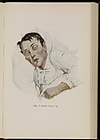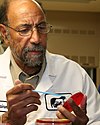Wikipedia:VideoWiki/Typhoid fever
| VideoWiki/Typhoid fever (Tutorial) | |
|---|---|
| Link to Commons | |
| Steps for video creation | |
| Step 1 | Preview my changes (10 sec) |
| Step 2 | Upload to Commons (10 min) |
Definition
Typhoid fever, also known simply as typhoid, is a bacterial illness caused by

Onset of illness
Symptoms typically begin, six to thirty days after exposure to food or water, contaminated with the feces of an infected person.[2]

Symptoms
Early symptoms may vary from mild to severe.[3][4] Usually, there is a gradual onset of a high fever over several days;[3] weakness, abdominal pain, constipation, headaches, and mild vomiting.[4][5]

Other symptoms
Some people will develop a skin rash, with rose colored spots.[4]

Severe cases and carriers
In severe cases there may be confusion.[5] Without treatment, symptoms may last weeks or months.[4]

Carriers
Other people may carry the bacterium without being affected; however, they are still able to spread the disease to others.[2]

Causes
The cause is the bacterium Salmonella Typhi, that grows in the

Spread
Typhoid is spread by eating or drinking food or water contaminated with the feces of an infected person.

Risk factor
Risk factors include poor sanitation and poor hygiene.[1]

Risk factor 2
Those who travel in the developing world are also at risk.[5]

Diagnosis
Because symptoms are similar to those of many other infectious diseases,

Bone marrow testing
Culturing the bacterium can be difficult, so [7] bone marrow testing is the most accurate.[6]

Prevention
The chlorination of public drinking water led to the sharp reduction of typhoid in developed nations.[8] In typhoid-endemic countries,

Typhoid vaccines have been shown to prevent 40 to 90% of cases during the first two years,[9] and may have some effect for up to seven years.[1]

Travel to endemic areas
Vaccination is recommended for those at high risk, or people traveling to areas where the disease is common.[2]

Other efforts
Other efforts to prevent the disease include providing clean
Infected persons quarantine
Until it has been confirmed that an individual's infection is cleared, the individual should not prepare food for others.[4]

Treatment
The disease is treated with

Resistance
Resistance to these antibiotics has been developing, which has made treatment more difficult.[1][10]

Epidemiology
In 2015, there were 12.5 million new cases worldwide.[11]

Epidemiology - geography
The disease is most common in India.[1]

Epidemiology - demographic
Children are most commonly affected.[1][2]

Prognosis
Rates of disease decreased in the

Risk of death
The risk of death may be as high as 20% without treatment, and 1 to 4% with treatment.[2]

History
The most notorious carrier of typhoid fever, but by no means the most destructive, was Mary Mallon, also known as Typhoid Mary.

History 2
In 1907, she was the first typhoid carrier identified and traced, while working as a cook in New York. She was associated with 53 cases and three deaths.[12]

History 3
She died of pneumonia after 26 years in quarantine.

References
- ^ PMID 25458731.
- ^ (PDF) from the original on April 2, 2015.
- ^ ISBN 9780199948499. Archivedfrom the original on 2015-07-02.
- ^ a b c d e f g h "Typhoid Fever". cdc.gov. May 14, 2013. Archived from the original on 6 June 2016. Retrieved 28 March 2015.
- ^ a b c d e "Typhoid Fever". cdc.gov. May 14, 2013. Archived from the original on 2 April 2015. Retrieved 28 March 2015.
- ^ PMID 20014951.
- ISBN 9781455740437. Archivedfrom the original on 2017-02-28.
- ^ Leal, John L. (1909). "The Sterilization Plant of the Jersey City Water Supply Company at Boonton, N.J." Proceedings American Water Works Association. pp. 100–9.
- PMID 29851031.
- PMID 30629573.
- PMID 27733282.)
{{cite journal}}:|first1=has generic name (help)CS1 maint: numeric names: authors list (link - ^ "Nova: The Most Dangerous Woman in America". Archived from the original on 2010-04-26.
